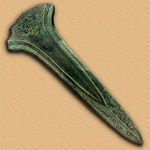History of materials science
The use of polished stone axes marks a significant advance, because a much wider variety of rocks could serve as tools.
The innovation of smelting and casting metals in the Bronze Age started to change the way that cultures developed and interacted with each other.
Typically, materials such as bone, fibers, feathers, shells, animal skin, and clay were used for weapons, tools, jewelry, and shelter.
[citation needed] As history carried on into the Mesolithic age, tools became more complex and symmetrical in design with sharper edges.
Nearing the end of the Stone Age, humans began using copper, gold, and silver as a material.
Through experimentation or by chance, additions to copper lead to increased hardness of a new metal alloy, called bronze.
Romans mixed powdered limestone, volcanic ash found from Mount Vesuvius, and water to make a cement paste.
With the fall of the west Roman Empire and the rise of the Byzans, this knowledge was mostly lost except to the catholic monks, who were among the few who could read Vitruvius’ Latin and make use of the concrete paste.
[6] That is one of the reasons that the concrete Pantheon of Rome could last for 1,850 years, and why the thatched farmhouses of Holland sketched by Rembrandt have long since decayed.
[8] The use of this material however was not without its downsides, Pliny the Elder, noted a link between the quick death of slaves to work in the asbestos mine.
[9] After the thighbone daggers of the early hunter-gatherers were superseded by wood and stone axes, and then by copper, bronze and iron implements of the Roman civilization, more precious materials could then be sought, and gathered together.
Thus the medieval goldsmith Benvenuto Cellini could seek and defend the gold which he had to turn into objects of desire for dukes and popes.
The use of cork, which has been recently added to the category of materials science, had its first mentions beginning with Horace, Pliny, and Plutarch.
[10] It had many uses in antiquity including in fishing and safety devices because of its buoyancy, an engraving medium, sandal soles to increase stature, container stoppers, and being an insulator.
[10] In Alexandria in the first century BC, glass blowing was developed in part due to new furnaces that could create higher temperatures by using a clay coated reed pipe.
In the 15th century, Johann Gutenberg develops type metal alloy and Angelo Barovier invents cristallo, a clear soda-based glass.
[citation needed] In the 18th century, William Champion patents a process for the production of metallic zinc by distillation from calamine and charcoal, Bryan Higgins was issued a patent for hydraulic cement (stucco) for use as an exterior plaster, and Alessandro Volta makes a copper or zinc acid battery.
Since aluminum is a light element with good mechanical properties, it was widely sought to replace heavier less functional metals like silver and gold.
[20] This process would allow aluminum to be manufactured cheaper than ever before, and laid the groundwork for turning the element from a precious metal into an easily obtainable commodity.
Around the same time in 1888, Carl Josef Bayer was working in St Petersburg, Russia to develop a method to make pure alumina for the textile industry.
This process involved dissolving the aluminum oxide out of the bauxite mineral to produce gibbsite, which can then be purified back into raw alumina.
MRS was the brainchild of researchers at Penn State University and grew out of discussions initiated by Prof. Rustum Roy in 1970.
As of 2006 [needs update], MRS has grown into an international society that sponsors a large number of annual meetings and has over 13,000 members.
The fundamentally interdisciplinary nature of MRS meetings has had a strong influence on the direction of science, particularly in the popularity of the study of soft materials, which are in the nexus of biology, chemistry, physics and mechanical and electrical engineering.
This in turn enabled computers to be used to solve complex crystallographic calculations and automate crystallography experiments, allowing researchers to design more accurate and powerful techniques.


